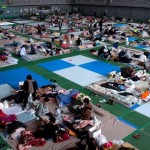This week has been undoubtedly one of the longest, most stressful weeks for me. Although a full seven days have gone by since the Sendai earthquake struck Japan, I still am not able to articulate the feeling of watching the country I grew up in, the country I love and admire, the country that is home to a landscape of memories, bleed. In fact, I am having a lot of trouble just writing this.
I’m not going to bore you with my life story, but to quickly summarize, I moved from Brooklyn to Japan in 1982 when I was one. My parents and I settled down in the quaint town of Koenji which, at the time, was home to roughly zero foreigners (I’m exaggerating but the number was minuscule). Koenji welcomed us in like family and thus began my simultaneous dual-absorption of cultures – Japanese amongst my friends at school and in the neighborhood and American at home. Japan nurtured me until, 18 years later, I was ready to venture out of my bubble to the States to attend college.
I owe so much of who I am to Japan…which is odd for me to even write because it’s so obvious I don’t give it much thought. Japan is not my second home. It is my home. And it’s bleeding.
What we’ve been doing here at Spoon & Tamago is, continuing to do what we do best. We’ve been shying away from all the sensational news stories out there, which, as predictable as they are, lead to a dangerous divergence in perception of the situation. Instead, all week long we’ve been writing about artists and designers who are doing their part to cope with the situation, make sense of the confusion and attempting to remedy what they can. You can read all our posts on the earthquake by following the tag 2011 earthquake. I realize that some of my posts may have alienated non-Japanese speakers, which, although I try not to do, was unavoidable.
While my thoughts are with the citizens during this painful and difficult time, I’m inspired by the courage and resilience being displayed. My hope is that still more are rescued from the rubble and that aid reaches those in desperate need. And I will continue to hope for life to return to normal as soon as possible.
Final thoughts
I don’t want this to sound like a conclusion, because that’s not what it is. Right now, as I write this, there are refugees who are freezing cold, trying to survive on what meager supplies are left. Some will not make it. Parents still suffer from the pain of losing children who were on their way home from school – a pain that thrusts my nails into my skin just trying to imagine what it might be like. Those in the field continue to deal with this nightmare 24 hours a day.
And yet, for me, as I replay the videos on youtube and gaze in utter disbelief at the slideshows, there is an overarching lesson that I will hopefully carry with me for years and years to come. And that is, no matter how high we construct our dams or how deep we build or breakwaters. No matter many wind turbines we erect or how much solar energy we convert, we will never control nature. And we should come to terms with that and respect nature for what it is; a force that is exponentially greater, more powerful and more significant than we will ever be.























